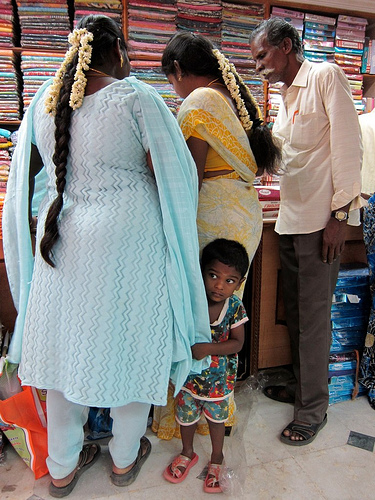Changing India
For me, one of the most intriguing aspects of our experience in India was the insight we got into the country’s social strata. As we traveled around visiting Suhail’s relatives and family friends, we passed through and paused in villages, mid-sized towns and large cities. Through the people we met, it was clear how different life in each of these places is today, especially for women.
Siruvanure Village
The ashram is located just outside Siruvanure village, which is just outside the town of Tiruvallur (population 45,000). This part of the Tamil Nadu state has seen investment by several international companies in the past few years, leading a shift from agriculture to factory work. After a fruitless internet search, I would guess Siruvanure’s population is between 600 and 800. Most of the villagers live in small houses packed around narrow roads shared by cars, motorbikes, cows, goats, chickens and mischievous children. The ashram is beyond the village, surrounded by rice paddies and sugar cane fields, so we were awakened by the rooster’s crow every morning. In this part of the world, most women wear saris or salwar kameez every day. If not, both shoulders and knees should still be covered at all times. This was probably one of the hardest cultural practices for me to follow, since it was over 90 degrees every day!
The Arpudum family run the ashram and hail from the village themselves. As a result, they have a very old-school village mentality. Poongothai, the matriarch, sort of took me on as her project, since I was hardly the picture of a respectable married woman by her standards. Every morning, she would crown me with a garland of jasmine flowers while complaining about how short my hair was. She also disapproved of my lack of gold, but was happy to see me dressed in a sari with a bit of jewelry for the special occasions we celebrated while there. Her greatest achievement was probably convincing me to get toe rings put on. I only got the full details later, but the tradition goes something like this:
In this part of Tamil Nadu, 3 toe rings are traditionally worn on each foot of a married woman – two on the second toe and one on the third. This (in place of our tradition of rings worn on the hand) represents the contract of marriage. When I agreed to get the rings, I did not quite realize exactly what was involved, as you can probably tell from the video below. The joys of traveling have a lot to do with being open to the unexpected, right?!
Bangalore & Delhi
As we traveled to larger cities, I learned that nearly all these traditions have lost their footing in modern India, as western culture has seeped in and given women more freedom. In Bangalore, we stayed with Suhail’s mother’s cousin, her niece and her family (got that?). They live in a tall, narrow townhouse in this bustling city known for high tech industries and heavy presence of foreign firms. I found it comforting to talk to Choti (the niece) since her lifestyle is one I can relate to more easily than many of the silent, obedient wives we had been meeting. She works full time (even though she is a mother of two), drives a scooter (even though this is generally frowned upon in smaller towns and villages) and is clearly more of an equal to her husband than most of the women we met.
At the end of our visit, we returned to Delhi to stay with Suhail’s cousin Clarissa again. Delhi is a pretty cosmopolitan city, though not nearly as much as Mumbai. Clarissa’s parents live near Chicago and she lives on her own, which is still almost unheard of in India. Even though she is independent and can support herself financially, women generally live at home until marriage, even in the most modern cities. It was wonderful to see Clarissa living her life as she sees fit, not selfishly or foolishly, but hopefully in a way that will allow her to find happiness. She is strong and independent and what she and others like her are doing will help pave the way for more freedoms for Indian women. While India has many values that we could use more of in the west (like a strong emphasis on doing whatever it takes to care for your family and friends), I think there is a place in India’s future for women to gain more freedom while upholding many of the country’s important cultural traditions.



Great read Kristen. The toe ring video is priceless. Safe travels – as always. Miss you and off to read more…Cheers for a lovely new year! Love ~ Ange & Joe
Thanks, guys – it has definitely been an interesting trip so far! I hope you both enjoy New Years too…you have certainly had an exciting year to reflect on. Miss you too!
OMG! You are such a brave woman with the toe rings! I’m wondering what Suhail wears as a married man in the Indian cultural sense. Can we expect a video of the process? Great seeing you on the net and reading all about your travels. Looks like Saigon has changed a lot since my last trip. Miss you!!!
Thanks, Donna! I think I was more confused/surprised/flabbergasted than brave! haha. The men get off pretty easy as far as I know…no surprise there (:
I am sure all of Vietnam is a different world since you were here. We have been surprised ourselves. Not really all that different from the western world. We did a motorbike trip for 4 days that got us out into the countryside, which was amazing. It was great to be off the tourist track for a bit as well. I will get photos & details of that posted asap. Now we are in Hoi An, and it is more like Disneyland. Miss you too – thanks for reading!